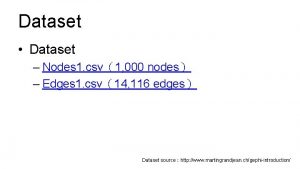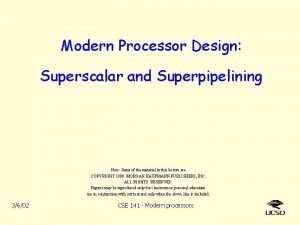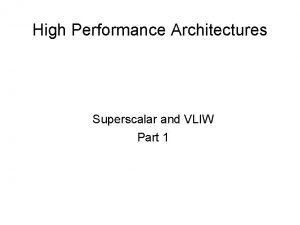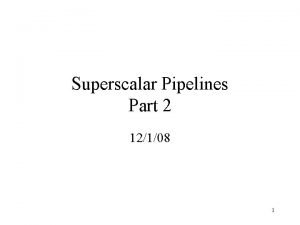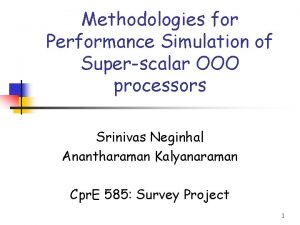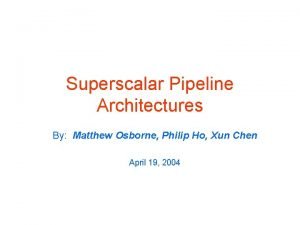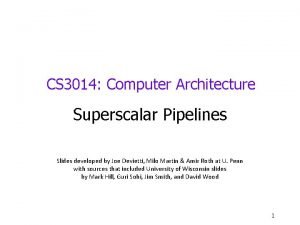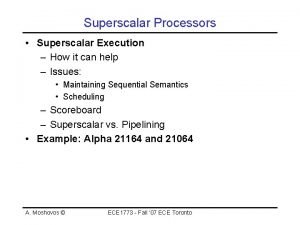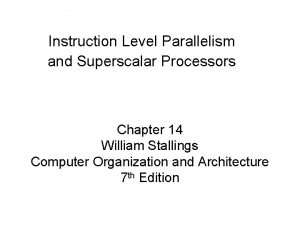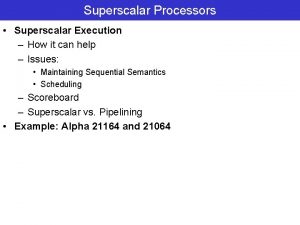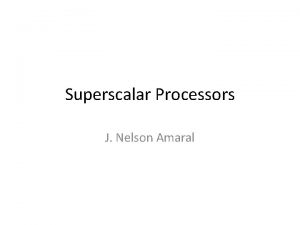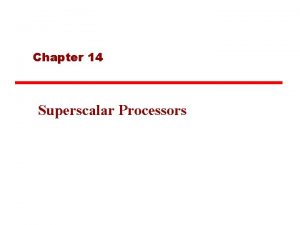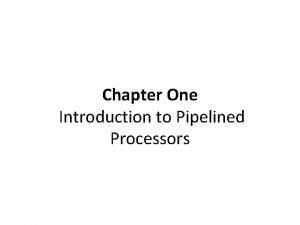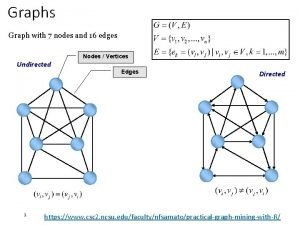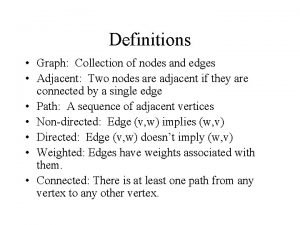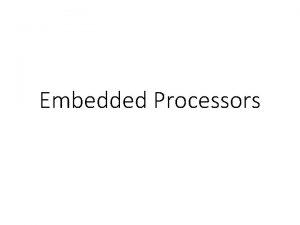Superscalar processors Review Dependence graph Nodes instructions Edges












- Slides: 12

Superscalar processors Review

Dependence graph • Nodes: instructions • Edges: ordered relations among the instructions • Any ordering based transformation that does not change the dependencies of the program will be guarantied not to change the result of the program. • Example • S 1: Load R 1, A / R 1 Memory (A) / • S 2: Add R 2, R 1 / R 2+R 1 / S 1 S 2

Data dependency • • • Flow dependence: Statement 2 uses a variable computed by Statement 1 must store/send the variable before Statement 2 fetches. S 1 S 2 Output dependence : Statement 1 and Statement 2 both compute the same variable and Statement 2's value must be stored/sent after Statement 1's. S 1 S 2 Antidependence: Statement 1 reads from a location into which the second statement stores. S 1 S 2 • Example S 1: Load R 1, A S 2: Add R 2, R 1 S 3: Move R 1, R 3 S 4: Store B, R 1 / / R 1 Memory (A) / R 2+R 1 / R 1 R 3 / Memory (B) R 3 / S 1 S 2 S 4 S 3

EXAMPLE • How long would the following sequence of instructions take to execute on an superscalar processor with two execution units, each of which can execute any instruction? Load operations have a latency of two cycles, and all other operations have a latency of one cycle. Assume that the pipeline depth is 5 stages. LD r 1, (r 2) ADD r 3, r 1, r 4 SUB r 5, r 6, r 7 MUL r 8, r 9, r 10

Example (cont. ) • In order execution • There are five pipeline stages and load has latency of 2 clock cycles • Fetch, Decode, Execution, Memory access and Write back are the pipeline stages • Total number of cycles is 8

Example (cont. ) • Out of order execution • There are five pipeline stages and load has latency of 2 clock cycles • Fetch, Decode, Execution, Memory access and Write back are the pipeline stages • Total number of cycles is 7 • Solutions

Register renaming • On an out of order superscalar processor with 8 execution units, what is the execution time of the following sequence with and without register renaming it any execution unit can execute any instruction and the latency of all instructions is one cycle? Assume that the hardware register file contains enough registers to remap each destination register to a different hardware register and that the pipeline depth is 5 stages. • • • LD r 7, (r 8) MUL r 1, r 7, r 2 SUB r 7, r 4, r 5 ADD r 9, r 7, r 8 LD r 8, (r 12) DIV r 10, r 8, r 10.

Solution • • • In this example, WAR dependencies are a significant limitation on paralle lism, forcing the DIV to issue 3 cycles after the first LD, for a total execution time of 8 cycles (the MUL and the SUB can execute in parallel, as can the ADD and the second LD). After register renaming, the program becomes LD hw 7, (hw 8) MUL hw 1, hw 7, hw 2 SUB hw 17, hw 4, hw 5 ADD hw 9, hw 17, hw 8 LD hw 18, (hw 12) DIV hw 10, hw 18, hw 10 (Again, all of the renaming register choices are arbitrary. ) With register renaming, the program has been broken into three sets of two dependent instructions (LD and MUL, SUB and ADD, LD and DIV). The SUB and the second LD instruction can now issue in the same cycle as the first LD. The MUL, ADD, and DIV instructions all issue in the next cycle, for a total execution time of 6 cycles.

Example • Figure on the next slide shows an example of a superscalar processor organization. The processor can issue two instructions per cycle if there is no resource conflict and no data dependence problem. There are essentially two pipelines, with four processing stages (fetch, decode, execute, and store). Each pipeline has its own fetch decode and store unit. Four functional units (multiplier, adder, logic unit, and load unit! are available for use in the execute stage and are shared by the two pipelines ana dynamic basis. The two store units can be dynamically used by the two pipeline depending on availability at a particular cycle. There is a lookahead window with its own fetch and decoding logic. This window is used for instruction lookahead for out of order instruction issue.

Example (cont. ) • • What dependencies exist in the program? Show the pipeline activity for this program on the processor using in order issue with in order completion policies and using a presentation similar to the Figure. Repeat for in order issue with out of order completion. Repeat for out of order issue with out of order completion.


 Nodes and edges dataset csv
Nodes and edges dataset csv Vpp graph nodes
Vpp graph nodes Vliw vs superscalar
Vliw vs superscalar Pipelining and superscalar techniques
Pipelining and superscalar techniques Superpipelined processor
Superpipelined processor Vliw vs superscalar
Vliw vs superscalar Pipelining and superscalar techniques
Pipelining and superscalar techniques Superscalar simulator
Superscalar simulator Superscalar architecture diagram
Superscalar architecture diagram Superscalar pipeline
Superscalar pipeline Superscalar vs vliw
Superscalar vs vliw Superscalar execution
Superscalar execution In order issue in order completion example
In order issue in order completion example
